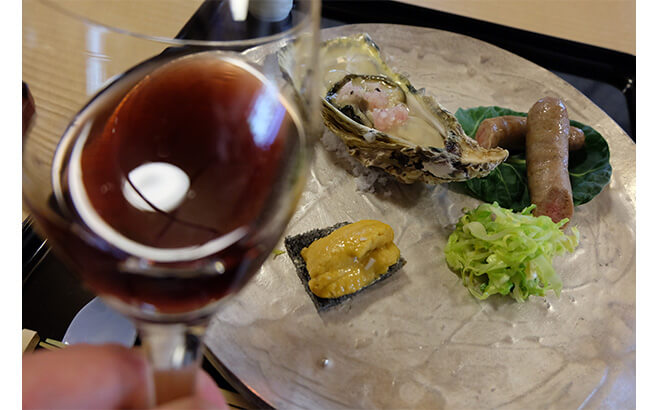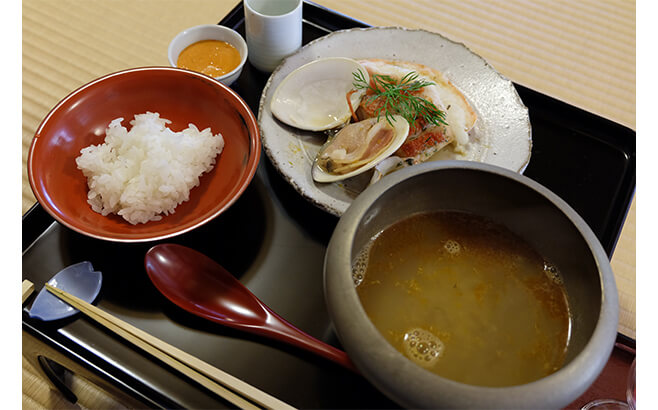Contemplating simple fare at an ancient setting in spring
Chefs share the spirit of Alice Waters’ “Simple food”
2014.06.23

From left: Yuri Nomura of eatrip, Jerome Waag of Chez Panisse and Shinobu Namae of L'Effervescence
Alice Waters is a gastronomic specialist who has advocated local production for local consumption, sustainable agriculture and distribution, as well as dietary education for more than forty years. Her restaurant, Chez Panisse, became a mecca for the “simple food” approach based on organic ingredients, creating a long-lasting impact on chefs around the world.
In April 2014, Chez Panisse head chef Jerome Waag journeyed to Japan, where he, Yuri Nomura, head of food creation team and restaurant eatrip, and Shinobu Namae, chef of L'Effervescence, gathered at the historic town of Kamakura for a special collaboration of these three chefs who paid their dues at Chez Panisse and are helping to spread the message of Alice Waters.
A story told with ingredients from Kamakura,Shonan
A parade of dishes featuring local ingredients.
Certain dishes offered up the bounty of natural Kamakura in a manner that guests could directly take in, with others featuring each chefs’ excellent technique. However, two dishes stood out which perfectly combined all ideas and cookery expertise of the chefs, displaying them in all their glory.
 |
One was “fresh oyster and grilled sausages” paired with a glass of Beau Paysage red wine.
The wine was produced in Tsugane, Sutamacho, Yamanashi Prefecture under the principle, “Focus on the grapes rather than the wine, and brew as simply as possible.” It is flavorful and nutritious, and, needless to say, excellent with organic fare. It was easy to predict that the wine perfectly matched the sausage handmade by Chef Namae and cabbage nurtured in the temple field, but it showed surprisingly good chemistry when paired with the oysters. These came from Shiraishi Lake, Mie Prefecture around the center of Japan, as they cannot be caught locally. They then tried to achieve a “marriage based on history.”
Any pairing between oysters and red wine is typically unsuccessful, as the harsh taste of the oyster comes out. However, at Bordeaux, famous for both its red wine as well as a marine climate with a long custom of oyster consumption, it is said that during the Middle Ages people ate oysters with the sausages to achieve the best paring with the red wine. Taking advantage of this historical tidbit offered up by Jerome, they experimented to see what would come of using this medieval Bordeaux technique in Kamakura, one of Japan's most ancient cities. As a result of this reinvention, guests were able to experience a splendid marriage of ingredients based on the historical background common to two cities that had established their culture at the same time, crossing the boundary between East and West and transcending centuries.
Starting from the framework of “Kamakura, Shonan,” they ventured further, expanding their scope to “Japan” to express the unique collaboration and tackle the challenge of finding flavor. This flexible approach may also be an influence of Chez Panisse.
 |
The other dish was “Kamakura Soup de Poisson and Onigiri (Japanese rice ball), with wild fennel.”
For this dish, they challenged the Japanese custom of serving rice as the closing course in their own special way. Jerome Waag, a native of Marseille, made soup de poison using seafood from Sagami Bay for the main ingredients of a bouillabaisse, a specialty of his hometown, and served it with a mayonnaise-based sauce using red chili and monkfish liver as an alternative to aioli sauce.
With this rice dish as a final course, guests could savor the taste changes by adding rice, seafood or sauce.
The layers of flavorful seafood umami permeating into the soup, the richness of the heavy oil from the monkfish liver, and the spicy taste of chili piled up one after another to evoke a joyful concert of flavor. Garnished fennel also provided a strong presence as an accent. They initially planned to use dried Californian fennel which Jerome had brought with him, but a local farmer unexpectedly delivered fresh fennel on the day which they were quick to adopt. A valuable connection with a local producer created a festive and tasty innovation for the event.
“Incorporate local ingredients into dishes that can be savored locally with the nature and environment of the home.”
This principle is a basic tenet for the chefs who carry the “simple food” message advocated by Alice Waters. However, they refuse to be limited by it, instead further developing dishes by adding their own know-how.
These chefs have their roots based in the seed of Alice’s philosophy, yet proudly grow into their own independent branches and leaves. This differs markedly from the traditional apprentice system where the novice faithfully reproduces the dishes of the master without deviating from their recipe and technique.









